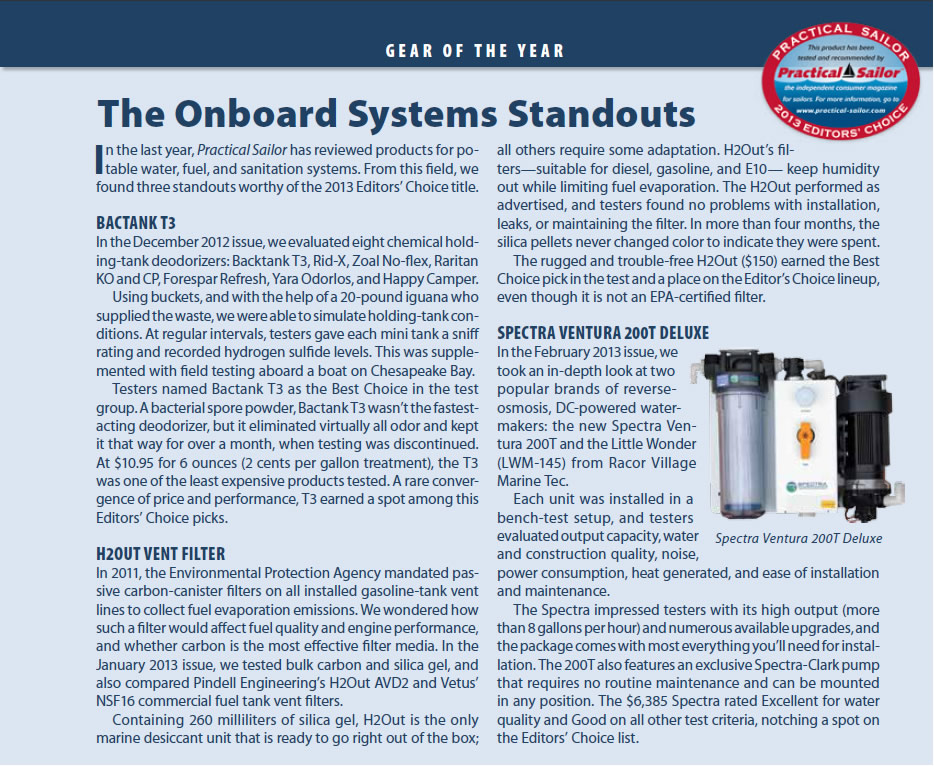Photos by Frank Lanier

With the fall boat shows on the horizon, its time for Practical Sailor editors to wade through the top-pick test products of the previous year to name the best of the best for our annual Editors Choice roster. Of the hundred-plus marine products we tested between September 2012 and September 2013, only 17 earned the designation as 2013 Editors Choice gear. These are products that clearly stood out among their peers during our independent tests as the best in their category and whose performance earned PS editors confidence and recognition.
The list is a guide of sorts, intended to help you navigate the unending array of products at the boat shows or make out your holiday wishlist. (For test details and a more in-depth look at each product, check out the original product reviews in our online archives.)
Standard Horizon RAM3
Remote mics are great tools for coastal and bluewater cruisers, but they can be essential for short-handed crews. In the September 2012 issue, we reviewed six remote microphones for fixed VHF radios. Taking the Best Choice title was the Standard Horizon RAM3 remote mic. It beat out the Garmin GHS10 and GHS20, Icom CommandMic III and CommandMic IV, and Raymarine RayMic. All but the wireless GHS20 were hard-wired to their host radio. We tested and compared the mics functionality (whether it allowed full control of host VHF), ease of operation, display screens, data displayed, audio systems, and water resistance.
The highly rated RAM3 is a full-function mic that works with nearly every fixed-mount VHF in Standard Horizons current lineup. The feature-rich RAM3 offers an intercom function, a mic speaker with noise-canceling technology, and backward compatibility to RAM+ (CMP25). Testers liked being able to configure the mics soft keys, which can be user-programmed for up to 10 functions that can be displayed in a user-prioritized order.
Testers rated audio quality as Good, the display as Very Good, and ergonomics as Excellent. The RAM3 remote mic costs $90 and carries a three-year warranty. The least expensive of the test field, it earned the Budget Buy and Best Choice picks in the test, securing a spot on our 2013 Editors Choice roster.
Ralph Naranjo
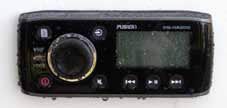
Fusion Stereo/Speaker Kit
Few sailboat owners mount their stereos in the cockpit-or need a fully waterproof unit-but its still good practice to find one that is marinized and at least splashproof. With that in mind, in our April 2013 issue, we set out to find the best-sounding, water-resistant, mid-priced marine stereos and stereo/speaker kits. We tested products from Dual Electronics Corp., Milennia, Poly-Planar, Sony, and Fusion Electronics. All the test stereos were standard, flush-mount units with AM/FM receivers and retail for $180 to $350.
Testers put the stereos and speakers through their paces in a series of bench tests that evaluated ease of installation, user friendliness, construction quality, audio quality, and power draw. After bench tests, the products faced water-resistance tests to verify maker claims.
When all was said and done, the $200 Fusion combo package stood out as the Best Choice and earned the Budget Buy. The stereo (MS-RA200SD) is designed to resist UV, moisture, salt, and vibration. The 200-watt, 6.5-inch coaxial speakers (MS-FR6520) had water-resistant plastic faceplates and housings, and injection-molded polypropylene cones. The Fusion stereo can receive digital audio from a computer or MP3 device via a USB port and accepts input from a Sirius radio.
Compact and easy to install, the bullet-proof Fusion stereo-speaker kit comes with a long list of features, highlighted by an external iPod dock and VHF monitoring capability. Its multi-zone volume control allows users to have one volume setting on deck and another in the cabin. The package had Excellent sound with crisp, clear highs and lows; testers found the Fusion speakers to have the best sound in the field.
Note that some retailers have ceased offering these two as a package, but we have found a few available online. West Marine has upgraded the package to a RA205 stereo with the EL602 speakers.
and Dave Gill

Icom M92
In the July 2013 issue, testers evaluated seven handheld VHF radios from Standard Horizon, Icom, and Midland. The test field faced a series of bench tests, including verifying waterproof ratings and measuring transmitter power output, frequency accuracy and stability, receiver sensitivity, and battery life. Testers also examined features, ergonomics, ease of use, and displays.
Although it was the most expensive unit in the test group ($299), the Icom M92D earned our Editors Choice pick for sailors who want all the bells and whistles or are seeking a handheld to use as their primary VHF. The M92D features active noise-canceling, DSC, and GPS.
Equipped with a 48-channel internal GPS and software features like a digital compass, waypoint database, and navigation functions, the M92D can serve as a back-up navigation device, in a pinch. It can also mark and navigate to that all-important MOB waypoint, the only radio in our group able to do so. Testers found the menu system to be straightforward and intuitive.
In water, the M92D floats in a face-up position and its entire keypad flashes as it produces an audible beep.
The M92D gives users the ability to make an emergency call with both position and nature of distress-what more could you ask a handheld radio to do?
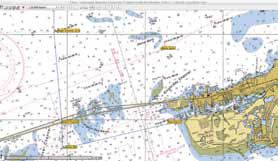
MacENC Software
In the July 2013 issue, we reviewed four navigation software programs for Macintosh systems: MacEnc, GPSNavX, Polar View, and OpenCPN. We tested each program in the field during cruises of a month or longer. We used the navigation programs on a number of Apple machines, including a MacBook Air. All four programs perform basic chartplotter functions well and vary mostly in user-friendliness and ancillary functions, such as connecting to other onboard instruments and receivers.
Testers found MacENC to be a more sophisticated program than the others and named it our Best Choice. Its on par with the most expensive PC programs, but at $180, it is a fraction of the price.
MacEnc uses vector charts (S-57 and S-63) and raster charts. In addition to the free NOAA raster and vector (ENC) charts of U.S. waters, it can use Navionics charts and other BSB and vector charts of world areas, including Canada, the Caribbean, and Europe. (These need to be purchased and downloaded through the x-traverse.com website.)
When using MacEnc, raster charts are quilted and work much like vector charts. For example, in planning a route, you can drag the screen to a different chart area and the chart will open automatically rather than having to do it manually as you do with other programs like GPSNavX. Integrating MacEnc with other on-board equipment (AIS, radar, autopilot, speed, etc.) through WiFi and NMEA (and/or a multiplexer) is fairly straightforward.
MacEnc can go toe-to-toe with a sophisticated chartplotter, and if you keep it below at the nav station, it is an excellent backup and repeat station.
Clearly the best marine navigation software program for Macintosh computers, MacEnc earned a spot on our Editors Choice roster.
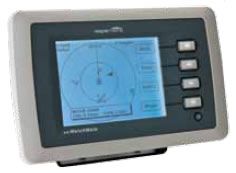
Vesper Watchmate 850
The Automatic Identification System (AIS) transmits dynamic information about a vessels speed, course, and position, along with static information including the vessels name, call sign, and Mobile Maritime Service Identity (MMSI) number over marine VHF frequencies. AIS devices are split into Class A (commercial) and Class B (recreational). Class A transceivers are required to broadcast more data than Class B units, and must update data more frequently. Class B transceivers are designed to provide a limited service, at a lower cost, to smaller vessels not required to carry a Class A unit.
In the September 2013 issue, we compared AIS Class B transceivers with integral displays: the Icom MA-500TR vs. New Zealand-based Vesper Marines WatchMate 850. The units went head-to-head in bench tests and field tests while testers cruised the waters of Hampton Roads, Va.-an AIS-target hotspot-with the WatchMate taking top honors.
The waterproof WatchMate 850 features very intuitive menus and a large, easily viewable, grayscale, LCD display, and has a display range from 0.25 nautical miles to 48 nautical miles. Two standout features of the WatchMate that were lacking in the Icom transponder were its internal GPS antenna (AIS transponders use GPS signals to get position data and VHF signals to send and receive other data), and its compatibility with and unique response to all AIS search and rescue / MOB devices. The WatchMates internal GPS receiver and GPS patch antenna greatly simplify installations; an optional externally mounted GPS antenna can be purchased for belowdeck installations.
What really set the WatchMate apart was its user-adjustable options for filtering displayed targets to reduce screen clutter. Testers also liked that the total number of targets tracked is always displayed, regardless of how aggressively you have them filtered.
Priced at $895, just slightly more than the Icom, Vespers WatchMate 850 simply brings a lot more to the table in terms of features, options, and display customization than the 500TR, earning it a place on the Editors Choice list.
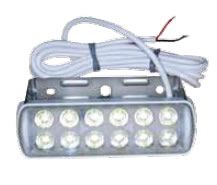
Hella Sea Hawk
In our August 2013 issue, we reviewed 10 LED spreader lights from Dr. LED, Forespar, Hella, Scandvik, and Signal Mate. We bench-tested each light and looked at how the light beam behaves at simulated spreader heights. Brightness was measured, field of coverage quantified, and the power consumption tracked.
It was a tough task to come up with a winner among the inline LED lamps, but Hellas Sea Hawk light, which offered a little less brightness, proved to be a current miser, and nosed out the competitors with its sensible, snag-free bracket design and lighter weight. Theres a fine art to illuminating the area from the mast step to the bowsprit, while keeping the helmsmans night vision intact, and the Hella Sea Hawk achieves that balance of competing interests.
The light has a 12-LED array and a polyamide lens that provides an even beam with good brightness that effectively and evenly illuminates the deck. The absolute brightness was a little lower than the four-LED inline units, but when looking aloft, the Hella lamp was not as blinding as the others.
The Hellas current consumption (0.3 amps at 12.6 volts DC) was half that of the slightly brighter Scandvik and Dr. LED units. Priced in the middle of the pack, the $136 Hella comes with an impressive five-year warranty.
It earned the Best Choice pick among LED spreader lights and a spot in the Editors Choice lineup.

Genoa Sheet Lead Controls
Today, any boat with a roller-furling headsail can benefit from the efficient, easily adjustable genoa-sheet leads that allow crew to optimize sail performance without having to leave the safety of the cockpit.
In the September 2013 issue, we reviewed 11 genoa-sheet lead controls for sailboats in the 35- to 40-foot range. These included gear from Antal, Garhauer, Schaefer, Harken, Nautos, and Seldn. Our goal was to measure the hardwares operational efficiency, design attributes, construction quality, and ease of installation; price and warranty were also considered.
Our test results showed that no one product answers all needs, but testers tapped the Harken G274B and G2747B cars as Best Choice for light-displacement boats and Schaefers 17-68 car as the Best Choice for bluewater voyagers and cruisers in far-flung locales. Both earned their place on the Editors Choice roster.
Harkens 27-millimeter G274B and G2747B cars had cleverly engineered, lock-in-place, Torlon recirculating ball bearings. The bearings stole the show when it came to slipping ball-bearing lead cars on and off the track. The G274B incorporates a pressed stainless-steel sheave cage, a nylon-resin GRP sheave, and a bushing-type bearing. The G2747B is identical, except the stainless block cage has a black abrasion-resistant coating and a tang for bungee attachment. It also has a very smooth spinning, larger-diameter sheave that uses ball and roller bearings to reduce friction during trimming. Both systems toggle 60 degrees to accommodate lead-angle offsets, and both sheave cages are wide enough to handle two sheets. The Harken cars are light and compact, but offer lots of power and easy handling.
The stainless-steel Schaefer 17-68 car features a nicely machined anodized-aluminum sheave cage, and the bushing-and-axle supported sheave offers a wide lead that will easily accommodate two sheets during sail changes. The car uses a high molecular-weight plastic track bushing as an alternative to ball and roller bearings. Its efficiency was not up there with the plastic ball-bearing gear we tested, but it is more likely to last the long haul. The slight increase in friction is a fair trade for its reliability and user-friendly maintenance abilities, in our opinion.
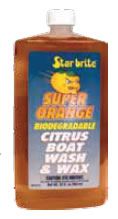
Star brite Boat Wash & Wax
Star brite Biodegradable Citrus Boat Wash & Wax, an eco-friendly gel cleaner, topped 12 other boat soaps and wash-and-waxes, including aerosol sprays, gels, powders, and liquids, in our search for a cleaner that is effective, easy to use, and affordable, and that wont remove wax or harm the marine environment, and can be used on a regular basis.
The test lineup included products from Star brite, Interlux, Woody Wax, Nautical Ease, 3M, Sudbury, and Marykate, as well as some automotive and home cleaners-Mothers, Ecover, Eagle One, and K2r. Most claim to be biodegradable and to remove dirt, mold, and mildew, and the majority can be used with salt water-although we don’t recommend it as salt is abrasive. The liquid- and gel-concentrate products seemed to be the most logical choice for all-around cleaning and working on large areas.
Testers used the products to clean soiled sections of fiberglass test panels, and then wiped each section with a clean white rag to determine whether any grime remained. Following the wipedown, testers conducted a water-beading test to see whether the products stripped wax from the panels. We also evaluated each one on ease of use, effectiveness, and pH balance.
Star Brite Citrus Boat Wash & Wax earned across-the-board Good ratings, the best of the bunch overall. The concentrated, eco-friendly wash and wax is safe to use on fiberglass, vinyl, metal, glass, plastic, and rubber surfaces. It costs about $22 for a 32-ounce bottle, or roughly 69 cents per ounce.
Photos by Frank Lanier

0)]
Active Youth PFDs
In the June 2013 issue, we reviewed six high-performance, U.S. Coast Guard certified Type III PFDs designed for youth sailors. The PFDs were made by Astral Designs, Extrasport, Gill, MTI Adventurewear, and Stohlquist. A Type III PFD is defined as a flotation aid; unlike a Type I or Type II PFD, they are not designed to help right a face-down wearer or to keep an unconscious persons head above water.
Two PS editors rated the youth PFDs with the help of five children, who fit the weight and chest profile of the vests (50 to 90 pounds). Vests were evaluated for ease of donning and doffing, and comfort and fit. In-the-water tests evaluated fit, ease of escape, buoyancy, slippage (when lifted by shoulder straps), and whether the wearer could swim easily. The top performers were the Extrasport Inlet Jr. and the Stohlquist Drifter, and both were named Best Choice PFDs for active youth sailors, earning spots on this years Editors Choice list.
The Inlet Jr. has plenty of reflective material on the shoulder straps and a loop for a whistle lanyard or other gear. The waist clip is easy to locate and release, and the flotation foam is shaped and beveled to form-fit the childs body, so fit was exceptional on our testers, and donning was easy. With few exposed buckles, this was the most snag-free jacket in our test. The $80 price, excellent fit, and useful features make this PFD an outstanding choice for the active youth sailor and small-boat racer.
The ruggedly built Drifter earned testers pick for a crossover jacket that can be used for paddling and sailing. The Drifters flotation panels contour nicely to the back and chest. The front foam is a little thicker than the Extrasport but sits lower on the body. The $90 Drifter offered excellent flotation, and a waist belt prevents it from riding up. The front panels are beveled at the neck and underarms, eliminating chafe, and the padded-neoprene shoulder straps are easy to adjust. Bonus features included a deep storage pocket, mesh side ventilation panels, reflective material on the front and back, and a place to attach a strobe, whistle, or personal locator beacon.
Photos by Frank Lanier

1)]
Gadget Protection
In the November 2012 issue, Practical Sailor tested a sampling of waterproof bags and cases marketed for use with cell phones, digital tablets, and e-readers to find out which ones can be trusted to protect your pricey gadgets from the dangers of life at sea.
We rounded up nine waterproof bags and hard cases from Aquapac, Lifedge, DryCASE, Watershed, LifeProof, and Aryca. Testers evaluated the level of device functionality the bags and cases allowed, and whether the devices buttons, charging port, and headphone port were accessible. Testers then submerged the products in 3 feet of fresh water for 30 minutes to test water-proofness claims, and dropped them from 3 feet onto concrete to gauge shock resistance.
All of the test products protected against water intrusion, so choosing the best one came down to personal preference (bag vs. case), price, and details. In the end, testers named the AquaPac for iPad as the top tablet/e-reader drybag, the LifeProof Nuud as the Best Choice tablet hard case, and the LifeProof 4/4S as the best protection for an iPhone. Because we have confidence in their waterproof design, these three earned their places on the Editors Choice roster.
The Aquapac drybag is similar to run-of-the-mill electronics drybags, but its thermoplastic polyurethane material isn’t tacky like the lower-grade-plastic bags, and it has better tactile contact with touchscreens. The Aquapac offers full function of the tablets screen and buttons, and it features a waterproof connector cord for headphones or speakers. The frosted-gray bag has clear screen and camera windows that rated Excellent for viewability and photo-taking. Testers also gave high marks for sound quality. Designed for all iPad models, the bag will accommodate Kindles and other tablets as well. It costs $60 and comes with a five-year warranty.
The slim-profile, lightweight LifeProof products were the only ones tested that allow users 100 percent function of the housed device, including access to all buttons and the charging ports, and have camera windows. The LifeProof Nuud comprises a clear back framed in polycarbonate and a front polycarbonate frame. The two pieces snap together and seal with O-rings. Because theres no screen cover for the iPad Gorilla-glass, the Nuud had the best viewability in the test field. The case front is raised above the iPad screen and has cushioning on its perimeter that acts as a shock absorber if the case is dropped. The Nuud retails for $130 and has a 90-day warranty.
We tested the LifeProof for iPhone 4/4S, which retails for $80, but cases are available for other iPhone models.
The LifeProof for iPhone is similar to the Nuud, but it has built-in clear plastic lenses that protect the phones screen and camera. The lightweight case has a rubber edge that offers grip but isn’t sticky like most silicone cases, so it easily slides in and out of pants pockets. It notched across-the-board Excellent ratings. Most warranties cover only the bag or case, not the contents inside. However, LifeProof now offers a water-protection program for the iPhone and iPad to those who purchase a LifeProof case on its website.
